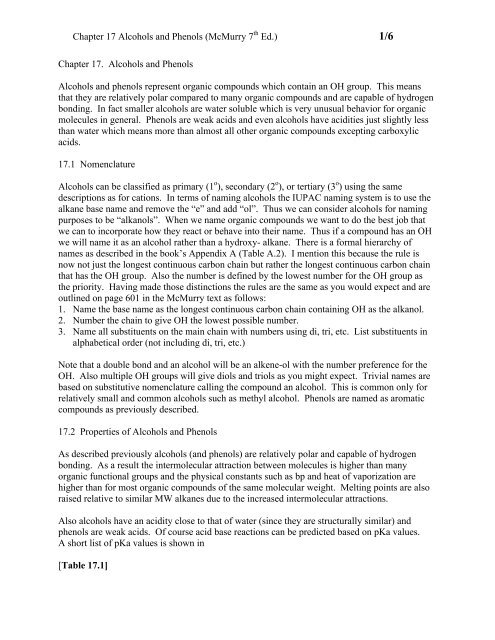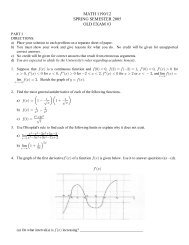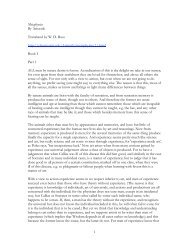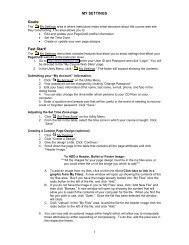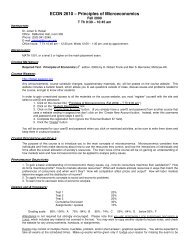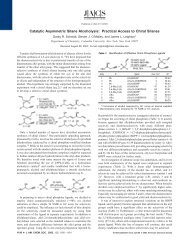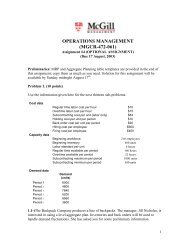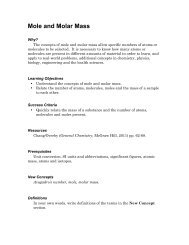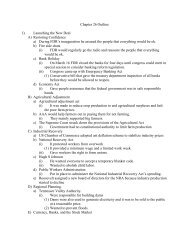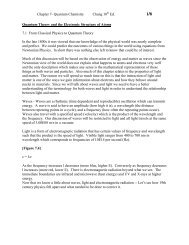Chapter 17 Alcohols and Phenols (McMurry 7th Ed ... - PageOut
Chapter 17 Alcohols and Phenols (McMurry 7th Ed ... - PageOut
Chapter 17 Alcohols and Phenols (McMurry 7th Ed ... - PageOut
Create successful ePaper yourself
Turn your PDF publications into a flip-book with our unique Google optimized e-Paper software.
<strong>Chapter</strong> <strong>17</strong> <strong>Alcohols</strong> <strong>and</strong> <strong>Phenols</strong> (<strong>McMurry</strong> 7 th <strong>Ed</strong>.) 1/6<strong>Chapter</strong> <strong>17</strong>. <strong>Alcohols</strong> <strong>and</strong> <strong>Phenols</strong><strong>Alcohols</strong> <strong>and</strong> phenols represent organic compounds which contain an OH group. This meansthat they are relatively polar compared to many organic compounds <strong>and</strong> are capable of hydrogenbonding. In fact smaller alcohols are water soluble which is very unusual behavior for organicmolecules in general. <strong>Phenols</strong> are weak acids <strong>and</strong> even alcohols have acidities just slightly lessthan water which means more than almost all other organic compounds excepting carboxylicacids.<strong>17</strong>.1 Nomenclature<strong>Alcohols</strong> can be classified as primary (1 o ), secondary (2 o ), or tertiary (3 o ) using the samedescriptions as for cations. In terms of naming alcohols the IUPAC naming system is to use thealkane base name <strong>and</strong> remove the “e” <strong>and</strong> add “ol”. Thus we can consider alcohols for namingpurposes to be “alkanols”. When we name organic compounds we want to do the best job thatwe can to incorporate how they react or behave into their name. Thus if a compound has an OHwe will name it as an alcohol rather than a hydroxy- alkane. There is a formal hierarchy ofnames as described in the book’s Appendix A (Table A.2). I mention this because the rule isnow not just the longest continuous carbon chain but rather the longest continuous carbon chainthat has the OH group. Also the number is defined by the lowest number for the OH group asthe priority. Having made those distinctions the rules are the same as you would expect <strong>and</strong> areoutlined on page 601 in the <strong>McMurry</strong> text as follows:1. Name the base name as the longest continuous carbon chain containing OH as the alkanol.2. Number the chain to give OH the lowest possible number.3. Name all substituents on the main chain with numbers using di, tri, etc. List substituents inalphabetical order (not including di, tri, etc.)Note that a double bond <strong>and</strong> an alcohol will be an alkene-ol with the number preference for theOH. Also multiple OH groups will give diols <strong>and</strong> triols as you might expect. Trivial names arebased on substitutive nomenclature calling the compound an alcohol. This is common only forrelatively small <strong>and</strong> common alcohols such as methyl alcohol. <strong>Phenols</strong> are named as aromaticcompounds as previously described.<strong>17</strong>.2 Properties of <strong>Alcohols</strong> <strong>and</strong> <strong>Phenols</strong>As described previously alcohols (<strong>and</strong> phenols) are relatively polar <strong>and</strong> capable of hydrogenbonding. As a result the intermolecular attraction between molecules is higher than manyorganic functional groups <strong>and</strong> the physical constants such as bp <strong>and</strong> heat of vaporization arehigher than for most organic compounds of the same molecular weight. Melting points are alsoraised relative to similar MW alkanes due to the increased intermolecular attractions.Also alcohols have an acidity close to that of water (since they are structurally similar) <strong>and</strong>phenols are weak acids. Of course acid base reactions can be predicted based on pKa values.A short list of pKa values is shown in[Table <strong>17</strong>.1]
<strong>Chapter</strong> <strong>17</strong> <strong>Alcohols</strong> <strong>and</strong> <strong>Phenols</strong> (<strong>McMurry</strong> 7 th <strong>Ed</strong>.) 2/6which shows that acidity is greatest for primary alcohols <strong>and</strong> that phenols can have changes inthe pKa depending on substituent effects. Electronwithdrawing groups will stabilize the anion<strong>and</strong> the acid will be greater (shown for nitrophenol) on page 606.<strong>17</strong>.3 Preparation of alcohols: Old ReactionsReactions that produce alcohols have already been described. The reaction of alkenes with water(hydration) that is normally in the presence of Hg(II) ions gives alcohols from alkenes(Markovnikov product) <strong>and</strong> hydroboration/oxidation gives the same product with the oppositeregiochemistry. This is shown in the[artwork on page 608]Also diols can be prepared from alkenes by the reaction of OsO 4 to give the syn diol. Theopposite stereochemistry (anti diol) can be obtained by epoxidation <strong>and</strong> ring opening with waterin acid or base. This is given in the[artwork on page 608]{Note: Please kindly disregard the comment on stereochemistry naming at the bottom of page608, Although this is sometimes done it is unusual. In fact you already know that if you wantedto name the diol products formed in the reactions described that the proper way to do so is toname the top compound is (1R) / (2S) <strong>and</strong> the bottom compound is (1S) / (2S) as covered in thestereochemistry chapter!}[Table 15.1C] Review of reactions used to form alcoholsNote that Table 15.1 also includes S N 1 /S N 2 reactions of alkyl halides to give alcohols as well asreactions we will discuss in <strong>17</strong>.5.<strong>17</strong>.4-5 Alcohol formation from carbonyl compounds.<strong>Alcohols</strong> <strong>and</strong> carbonyl compounds such as aldehydes (RCHO) <strong>and</strong> ketones (RCOR’) havecarbon a different oxidation numbers. Therefore it is not a surprise that these two types offunctional groups can be interconverted by oxidation/reduction reactions. The reduction ofaldehydes <strong>and</strong> ketones will give alcohols. There are several compounds of hydrogen with metals<strong>and</strong> other materials but we will examine only two since they are so common: LiAlH 4 <strong>and</strong>NaBH 4 . In both cases these reagents are called “hydride transfer reagents” since they addhydrogen as the ion H - . These reductions can also occur using hydrogen <strong>and</strong> a catalyst such asPd, Pt or Ni but this will not work if C=C or C=C bonds are present since hydrogenation of thosebonds will happen preferentially.The carbonyl group (C=O) is inherently polar due to the electronegativity difference betweencarbon <strong>and</strong> oxygen. As a result the carbon is partially positive <strong>and</strong> the oxygen is partiallynegative. Nucelophiles (including H - ) are attracted to the carbonyl carbon <strong>and</strong> since it is a
<strong>Chapter</strong> <strong>17</strong> <strong>Alcohols</strong> <strong>and</strong> <strong>Phenols</strong> (<strong>McMurry</strong> 7 th <strong>Ed</strong>.) 3/6double bond the C=O bond can break. This means that C=O groups are excellent Lewis Acids(Electrophiles) in a variety of reactions. Sodium borohydride <strong>and</strong> Lithium Aluminum Hydride(LAH) both have hydrogen attached to an atom which is less electronegative than hydrogen (B isclose at 2.0 relative to hydrogen at 2.1; Al is 1.6) <strong>and</strong> as a result the polarity of the H-X bond isreversed from what we commonly find <strong>and</strong> H controls more of the electron density. In additionboth boron <strong>and</strong> aluminum as group III elements satisfy the octet rule by bonding with anadditional hydrogen to give the hydride anions BH 4 - <strong>and</strong> AlH 4 - . These are octet stabilized buthave a charge <strong>and</strong> they can relieve the charge by transferring H- if a suitable acceptor isavailable. These two reactivity patterns (C=O as a Lewis Acid) <strong>and</strong> the ability to transferhydride make these very favorable reactions. Representative examples are give in the[artwork on page 610; Mechanism 15.1C]Sodium borohydride is less reactive than LAH <strong>and</strong> is commonly used in protic solvents such asalcohols (as you did in the lab). It also means that it reacts well with aldehydes <strong>and</strong> ketones butnot less reactive C=O compounds which require the higher reactivity of LAH. LithiumAluminum hydride reacts fairly violently will all protic compounds <strong>and</strong> reactions using LAH arerun in the same solvents as for Grignard reagents (ether <strong>and</strong> THF are common).LAH is a reactive enough hydride transfer reagent to reduce not only aldehydes <strong>and</strong> ketones butesters <strong>and</strong> even acids. If the case of acids excess reagent needs to be used since the acidichydrogen reacts to form hydrogen gas (acid-base reaction). In both cases two equivalents of H -are added <strong>and</strong> the product will be a primary alcohol.<strong>Alcohols</strong> can also be prepared by the reaction of organometallics with C=O compoundsincluding esters (which as with hydride transfer reagents requires 2 equivalents of RMgX).[artwork on page 614]Of course adding Grignard reagents gives secondary (reaction with aldehyde) or tertiary(reaction with ketone or ester) alcohols. Also be aware that organolithiums will give productssimilar to Grignard reagents. Since these are strongly basic compounds there are compatibilityissues with any acidic protons involving these reagents.<strong>17</strong>.6 Reactions of <strong>Alcohols</strong>We have already seen several reactions of alcohols which include substitution reactions with HXto form alkyl halides <strong>and</strong> acid-catalyzed dehydration to form alkenes. We more briefly discussedreactions with thionyl chloride <strong>and</strong> phorosphorous tribromide to form chlorides <strong>and</strong> bromides.Also the conversion of alcohols to tosylates to improve the leaving group for SN2 chemistry wasalso discussed briefly. These reactions are outlined in table 15.2C.[Table 15.2C]The reaction of tertiary alcohols with HX is an S N 1 reaction proceeding via a carbocation.Primary <strong>and</strong> secondary alcohols can form RX via an S N 2 reaction but it is common to use more
<strong>Chapter</strong> <strong>17</strong> <strong>Alcohols</strong> <strong>and</strong> <strong>Phenols</strong> (<strong>McMurry</strong> 7 th <strong>Ed</strong>.) 4/6reactive regents to convert alcohols to alkyl halides. To convert to chlorides thionyl choride iscommon <strong>and</strong> for bromides PBr 3 is common. The synthetic utility to converting an alcohol intoan alkyl halide is to subsequently react with a nucleophile (better for primary or secondary due tocompetition from elimination for tertiary). Thus another common reaction is convert an alcoholinto a sulfonate ester R-OSO 2 R’) such as tosylate (R’ =tolyl), mestylae (R’ = CH 3 ) or triflate (R’= CF 3 ) all of which are highly reactive in S N 2 reactions.[Figure <strong>17</strong>.5; note that top reaction is retention due to 2 sequential S N 2 reactions (a doubleWalden inversion)]Dehydration of alcohols (elimination)Treatment of alcohols with acid which do not have a good nucleophilic anion such as sulfuricacid <strong>and</strong> under conditions that favor elimination over substitution such as high temperature willgive alkenes as products. The product distribution tends to favor the more substituted (morestable) alkenes following Zaitsev’s Rule. The mechanism is given in[Figure <strong>17</strong>.6]<strong>and</strong> an alternative to strong acid <strong>and</strong> high temperature is POCl 3 that performs the same reactionunder milder conditions.One final reaction we will consider is the reaction between alcohols <strong>and</strong> carboxylic acids(RCO 2 H) to form (carboxylic) esters (RCO 2 R’). This is called a condensation reaction becausea by-product forms which is a small stable molecule (water). Historically these are calledcondensations because when physically observing the reaction water could be observedcondensing. Commonly a condensation produces water although other small molecules such asammonia or alcohols can also form depending on the reaction run. An example of esterificationis shown in the[artwork on page 623].General form: RCOOH + HOR’RCOOR’ + H 2 OThis reaction is an equilibrium <strong>and</strong> therefore can be forced to completion by the removal ofwater during the reaction <strong>and</strong>/or using a large excess of reactants such as the alcohol.Example:
<strong>Chapter</strong> <strong>17</strong> <strong>Alcohols</strong> <strong>and</strong> <strong>Phenols</strong> (<strong>McMurry</strong> 7 th <strong>Ed</strong>.) 5/6An alternative way to form esters is to improve the leaving group on the C=O. Thus acidchlorides (RCOCl) <strong>and</strong> anhydrides (RCOOCOR) may be used to form esters more quickly <strong>and</strong> toshift the equilibrium such that the reaction is essentially irreversible.Example:Note that in the formation of esters the R group attached to the OH of the alcohol is not changed<strong>and</strong> if chiral will retain its configuration.Of less importance is the reaction with inorganic acids which can also form esters. Of these youshould be aware of use of the tosyl group to form reactants suitable for SN2 reactions. Similarcondensation reactions can occur for nitric acid, sulfuric acid or phophoric acid. In general theonly inorganic esters viewed as important are the nitrites such as in the formation ofnitroglycerin.<strong>17</strong>.7 Oxidation of alcoholsWe started the chapter by saying that alcohols could be prepared by the reduction of carbonylcompounds. That reaction can be reversed by using a different reagent. Oxidation reactions(again meaning the oxidation of the organic portion) can be perfomed on alcohols using acompound capable of being reduced such as Chromium (VI) compounds. The oxidation willhave different products depending on the type of alcohol reacted. Thus we differentiate alcoholsas being primary, secondary or tertiary. The oxidation occurs by the removal of hydrogensattached to the carbon with the OH. Thus oxidation depends on the presence of these hydrogens(just as the presence of a beta hydrogen was required for elimination).[artwork page 623-4]Primary alcohols will react with Cr (VI) to form the corresponding aldehyde.RCH 2 OH + Cr(VI) RCHO but the aldehydes still having a hydrogen adjacent to the C=O areoften further oxidized to the acids. Some chromium compounds such as pyridiumchlorochromate (PCC) can stop at the aldehyde; most other will continue on to the acid.Secondary alcohols will also form the carbonyl compound, in this case a ketone RCOR’. In thiscase there is not hydrogen on the C-O after oxidation <strong>and</strong> the ketone is the final product.
<strong>Chapter</strong> <strong>17</strong> <strong>Alcohols</strong> <strong>and</strong> <strong>Phenols</strong> (<strong>McMurry</strong> 7 th <strong>Ed</strong>.) 6/6Tertiary alcohols do not have any hydrogen on the C-O carbon <strong>and</strong> therefore will not react withoxidizing agents.The oxidation of primary <strong>and</strong> secondary alcohols is also used as a qualitative test for thesecompounds since chromium VI (orange) is reduced to chromium (III) (green). This is also thechemistry used in Breathalyzers in which exhaled (ethanolic rich!) air is passed through orangeoxidizer to give a green positive test <strong>and</strong> loss of license as described on page 637.[Table 15.5C; note PDC <strong>and</strong> PCC give the same result]<strong>17</strong>.7 TMS as a protecting groupObviously from this chapter there are more <strong>and</strong> more reactions that can be used synthetically.Sometimes incompatibilities or other potential problems can be overcome synthetically simplyby changing the order of steps in a reaction. Sometimes that is not enough <strong>and</strong> another strategythat is used synthetically is to protect or ‘mask’ a functional group. Since alcohols are such animportant potential intermediate since they undergo so many different reactions it might benecessary to protect an alcohol during a synthesis. For a protecting scheme to be useful theintroduction of a protecting group must be reversible. For alcohols one protecting group is theTMS (trimethyl silyl) group in what is called a TMS ether. An SN2 reaction with TMS-Cl givesthe substitution product. Subsequent reactions such as Grignard reactions or oxidations can beperformed with the TMS group present. Removal of the TMS group with fluoride ion (Si-F is avery strong bond) or acid hydrolysis returns the OH group. You should be aware of the utility ofthis approach relative to planning a synthesis.<strong>17</strong>-9-10 <strong>Phenols</strong> (note omit mechanism in Figure <strong>17</strong>.10)<strong>Phenols</strong> as previously noted are aromatic compounds with an OH on the ring. They are muchmore acidic than alcohols due to resonance delocalization of the anion formed. Also you knowthat OH is a strong donating groups <strong>and</strong> phenols are activated relative to benzene in EASreactions. One special type of oxidation of phenols is the formation of quinones (the reason thatapples turn brown when exposed to air helped with enzymes) which like other oxidationreductionreactions can be reversed.<strong>17</strong>.11 Spectroscopic analysis of alcohols.The most characteristic spectroscopic clue to the presence of an alcohol is the strong broad IRabsorption between 3200-3600 cm-1. Also present in the IR is the C-O stretch at 1050-1200 cm -1 .In the NMR the most characteristic peak is the C-H which is bound to the OH. This will have achemical shift of 3.2-3.8 ppm. The OH NMR absorption is not reliable since it is variable inchemical shift <strong>and</strong> can be broad. Also since phenols are electron rich the aromatic resonancestend to be on the upfield side of typical aromatics (6.8-7.2 ppm).Review of reduction reactions [Table 15.3C]Review of reactions [Table 15.4C]


